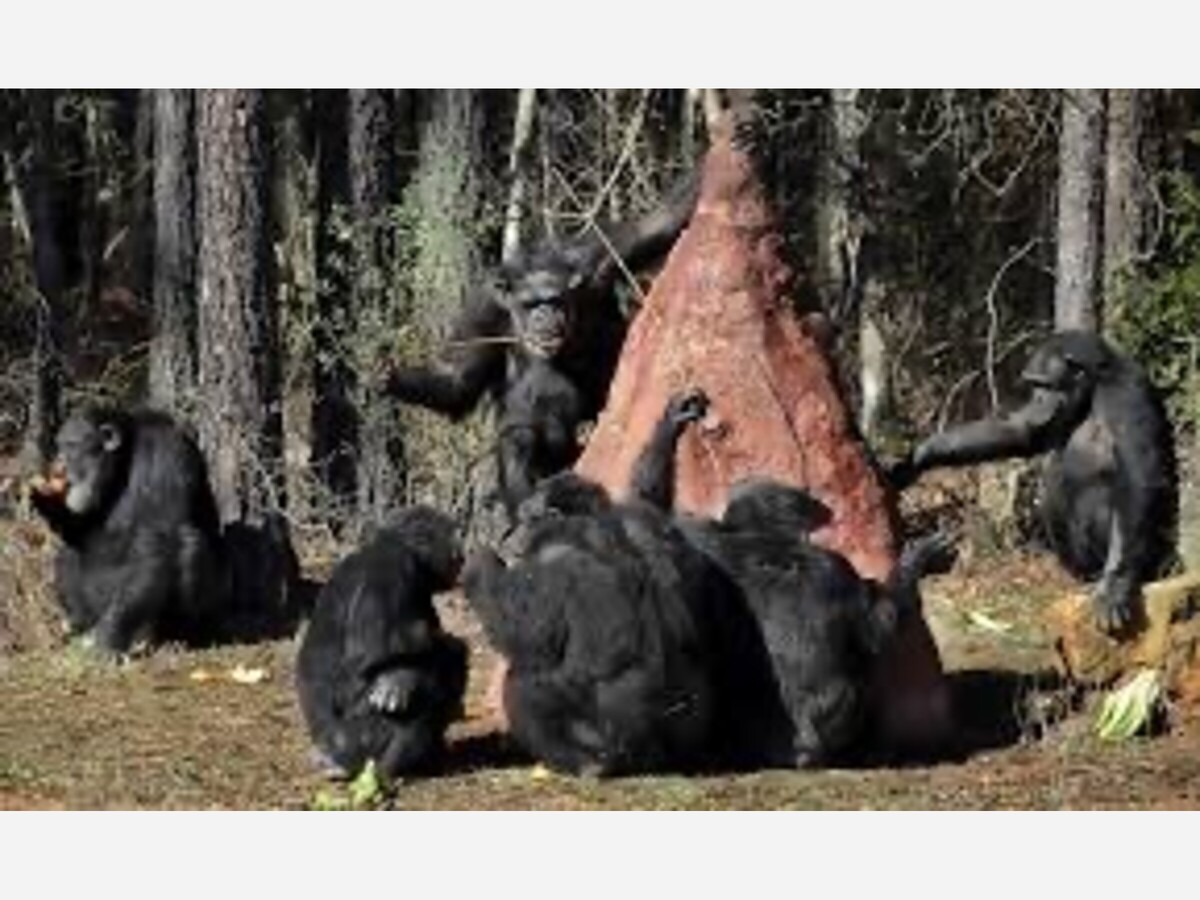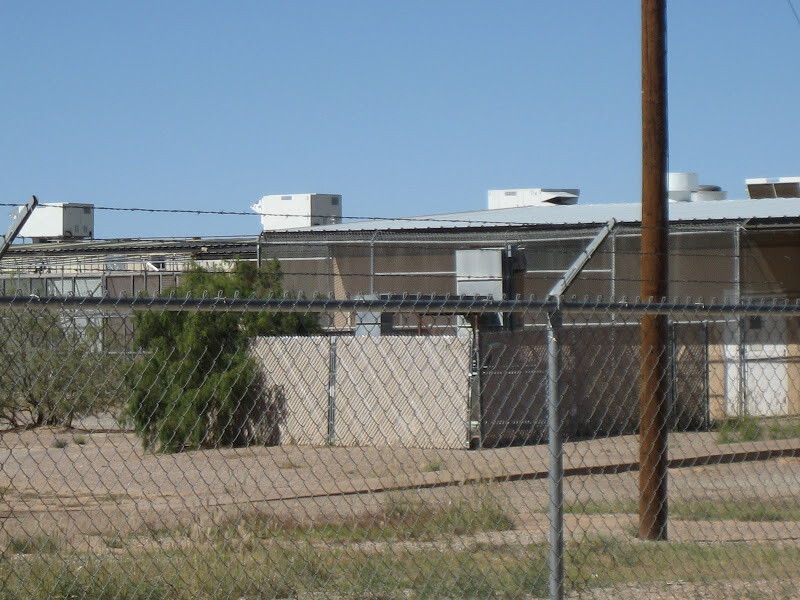Image


Judge again rules to move chimpanzees.
 Alamogordo Primate Facility
Alamogordo Primate FacilityThe Alamogordo Primate Facility (APF) located at Holloman Air Force Base, Alamogordo, New Mexico houses chimpanzees that have been used in biomedical research. No active, invasive research is conducted on the site now. Chimpanzees have been bred for research in Alamogordo since the 1950s, and at one point, the state with Alamogordo leading the research was home to the largest captive chimpanzee colony on the planet.
The APF provides for the long-term care and husbandry of chimpanzees that have been used in biomedical research. Charles River Laboratories Inc. operates the facility under contract with the National Institutes of Health.
All chimpanzees at the APF have been exposed to various microorganisms, such as hepatitis C virus and HIV. The animals are housed in social groups with indoor and outdoor enclosures.
There are 35 chimpanzees living at the Alamogordo Primate Facility, down from 44 in 2019, according to National Institutes of Health (NIH) reports.
The Chimpanzee Management Reports released October 1, 2021, said the number of animals held in Alamogordo - and across facilities nationwide - were expected to decrease "annually as a result of normal mortality."
"NIH conducts an annual census of its owned and supported chimpanzees after the end of each fiscal year (September 30) to provide the public with official figures on their numbers and cost of care," according to the report.
The mortality rate across the entire National Institutes of Health chimpanzee program was 3.2% for fiscal year 2021, "which is within the expected range. The number of animals at different facilities may also increase or decrease as a result of relocation," the report states.
On Monday a federal judge in Maryland ruled in favor of animal rights activists and chimpanzees in a case brought against the National Institute of Health for violating the Chimpanzee Health, Improvement, Maintenance and Protection (CHIMP) Act and its continued hosting of the animals in Alamogordo, New Mexico.
The CHIMP Act created and funded the federal chimpanzee sanctuary system which includes Chimp Haven in northwest Louisiana.
The federal judge ruled that the National Institutes of Health (NIH) violated the law when it determined that former research chimpanzees in New Mexico would not move to a sanctuary in Louisiana known as Chimp Haven.
After the NIH stopped supporting invasive biomedical research on chimpanzees in 2015, it started transferring chimps from research centers to Chimp Haven, a 200-acre property with a staff of dozens who care for more than 300 chimps.
Primates at this federal sanctuary tend to live in larger social groups than chimps do at research facilities, and have access to natural forests.
Some chimps, however, were deemed by the NIH to be too sick and frail to make the move. Officials noted that being trucked to a new home can be a stressful change for older animals that have spent decades living in one familiar place.
In October of 2019, the NIH announced that dozens of chimps would not be leaving the Alamogordo, New Mexico Primate Facility (APF) for that reason.
The Humane Society of the United States and other groups challenged this decision, saying that a law passed in 2000 as the CHIMP act required that the APF chimps be given the opportunity to retire at Chimp Haven and that the NIH did not have the discretion to declare them ineligible to go.
Some animal welfare advocates, however, question how NIH officials and veterinarians have been making these decisions. They say even more chimps should get the chance to live the rest of their lives at a sanctuary.
In press reports with the AP it was reported that; "If you look at the medical summaries for some of the chimps, a lot of them will say, 'Well, we're concerned that there'll be a sudden heart attack if the chimps are moved,'" says Kathleen Conlee, vice president of animal research issues at the Humane Society of the United States. "Chimpanzees are notorious for cardiac problems anyway. You could be a completely healthy chimpanzee at 16 years old and die from a heart attack, quite frankly. So to us, that's not a reason to keep them sitting in the labs."
Her group and others have sued the NIH over the fate of 35 chimps that the agency says need to stay at the Alamogordo Primate Facility in New Mexico.
Even a relatively old chimp could continue to live for years; the three oldest chimps at Chimp Haven are all 61 years old and are believed to have been captured in the wild in the 1960s. One of them was in her 50s when she moved from a research facility to the sanctuary.
The history of the Alamogordo Primate Facility is long and tenuous.
Beginning in the 1950s, the United States Air Force began maintaining a chimpanzee “colony” at the Holloman Air Force Base to conduct aeronautical and space research.
The initial population was composed of 65 young and infant chimpanzees captured from Africa. By 1970, the Air Force had ended its chimpanzee research and was leasing the chimpanzees to biomedical laboratories. Management of the chimpanzee lab at the Holloman Air Force Base was contracted to toxicologist Frederick Coulston, who was an avid proponent for the use of chimpanzees in cosmetics and insecticide testing, among other things.
In 1981, New Mexico State University assumed management of the Holloman chimpanzee lab. However by 1993, management of the facility and its chimpanzees was once again taken over by Coulston; that same year the infamous Coulston Foundation was incorporated and over time eventually cared for some 650 chimpanzees, the world’s largest holding. Under Coulston, chimpanzees were bred for and used in invasive research involving toxicology, infectious diseases, and drug testing.
After several years of repeated Animal Welfare Act (AWA) violations under Coulston, NIH assumed custody of 288 of Coulston’s chimpanzees in 2000 and agreed to the Air Force’s stipulation that no further research be allowed at the Holloman facility.
On April 20, 2001, NIH stated in a Memorandum of Understanding, “Under an agreement among the Coulston Foundation, the NIH, and the United States Department of Agriculture…, the NIH assumed ownership of the animals and committed to care for the chimpanzees at a particular set of facilities on the Holloman Air Force Base, New Mexico (under contract) to be known as the Alamogordo Primate Facility (APF). The APF and all animal activities conducted therein are covered by a Use Permit between the NIH and the United States Air Force. The APF will be operated as a Government Owned – Contractor Operated entity.”
In 2002, Coulston declared bankruptcy due to financial collapse from AWA violations and mismanagement, and its 266 remaining chimpanzees were rescued by Save the Chimps (STC). With substantial funding from the Arcus Foundation, along with additional funds from several animal protection groups including NEAVS, STC was able to purchase the Coulston facility and has since relocated all of the chimpanzees to their permanent sanctuary in Fort Pierce, Florida.
Unfortunately for the chimpanzees housed at APF, many problems still remained. In 2001, NIH awarded a ten-year, $42.8 million contract for the care and maintenance of the APF chimpanzees to CRL—the world’s largest animal breeder, importer, and private supplier of animal “models” for research. Despite the notorious AWA violations at Coulston, when CRL gained responsibility for the care of the APF chimpanzees, it retained many of the same employees—including veterinarians—who had been employed at Coulston during the time of its numerous animal welfare violation charges.
In 2004, CRL and the APF Director Dr. Rick Lee were charged with three counts of animal cruelty for the deaths of two chimpanzees, Ashley and Rex, and the neglect and suffering of a third chimpanzee, Topsy. The charges were filed by District Attorney Scot Key, whose investigation was prompted by evidence supplied by In Defense of Animals and their network of whistleblowers at APF. According to court documents, under CRL’s care “about 21 chimpanzees have died…over a two-year period either by natural causes or neglect by personnel;” this includes the deaths of three chimpanzees who died by electrocution due to unsafe conditions at the facility. Sadly, the cruelty charges were dismissed on a legal technicality having nothing to do with the merits of the case.
In 2010, through a Freedom of Information Act (FOIA) request NEAVS/Project R&R learned that 62 chimpanzees have died at APF between 2001 and 2010.
In June 2010, NIH announced that it would transfer all of the chimpanzees at APF to the Southwest National Primate Research Center (SNPRC) in Texas, where they would be offered for use nationwide in invasive hepatitis, cancer, autoimmune disease, and other research. NIH stated that with its 10-year contract with CRL soon ending, the relocation of the APF chimpanzees to the SNPRC would save $2 million a year while making all the chimpanzees available for research.
An intense public outcry against NIH’s decision immediately ensued; New Mexico citizens and supporters nationwide, animal protection groups, celebrities, scientists, and New Mexico Governor Bill Richardson all joined together in protest against NIH’s plan. NIH, however, appeared unmoved and in July proceeded to transfer 14 chimpanzees from APF to SNPRC, with plans made to move the rest by early 2011. NEAVS/Project R&R and other national groups, including Animal Protection of New Mexico, remained firm and continued to urge NIH to keep the chimpanzees in New Mexico.
In December, U.S. Senators Jeff Bingaman, Tom Harkin, and Tom Udall wrote to NIH and requested an independent study on whether or not chimpanzees were necessary for biomedical research.
On January 4, 2011, NIH issued a statement saying the transfer of the chimpanzees from APF to SNPRC would be suspended “pending an Institute of Medicine in-depth analysis to reassess the scientific need for the continued use of chimpanzees….”
At NIH’s request, the Committee on the Use of Chimpanzees in Biomedical and Behavioral Research was formed by the National Academy of Sciences’ Institute of Medicine (IOM) in collaboration with the National Research Council.
From May through November 2011, the committee deliberated and held “three 2-day meetings and several conference calls, including two public information-gathering sessions on May 26, 2011, and August 11-12, 2011.” NEAVS/Project R&R testified before the IOM in both of the information-gathering sessions. On December 15, 2011, the IOM released the results of their nine-month long study commissioned by NIH to investigate the current and future need for chimpanzees in research. The IOM concluded that “…most current biomedical research use of chimpanzees is not necessary.” The only exception was their “inconclusive” decision (a 5-5 split) regarding a “narrow area” of hepatitis C vaccine work.
Aside from the federally supported sanctuary Chimp Haven, APF is the only “non-research primate facility funded by NIH that maintains only chimpanzees.”
In late 2016, two chimpanzees at APF were moved to Chimp Haven, made possible by a $112,000 grant by the Chimpanzee Sanctuary Fund.
The most recent ruling concluded that the National Institutes of Health (NIH) violated the law when it determined that former research chimpanzees in New Mexico would not move to a sanctuary in Louisiana known as Chimp Haven.
And so as of today the chimpanzees of Alamogordo still hang in legal limbo.